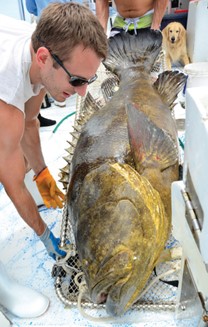What You Need to Know About Mercury in Fish and Shellfish
www.webmd.com
Fish and shellfish are an important part of a healthy diet. Fish and shellfish contain high-quality protein and other essential nutrients, are low in
saturated fat, and contain omega-3 fatty acids. A well-balanced diet that includes a variety of fish and shellfish can contribute to heart health and children's proper growth and development. Women and young children in particular should include fish or shellfish in their diets due to the many nutritional benefits.
However, nearly all fish and shellfish contain traces of mercury. For most people, the risk from mercury by eating fish and shellfish is not a health concern.
Yet some fish and shellfish contain higher levels of mercury that may harm an unborn baby or young child's developing nervous system.
The risks from mercury in fish and shellfish depend on the amount of fish and shellfish eaten and the levels of mercury in the fish and shellfish. Therefore, the Food and Drug Administration (FDA) and the Environmental Protection Agency (EPA) are advising young children and people who may become pregnant, are pregnant, or are nursing to avoid some types of fish and eat fish and shellfish that are lower in mercury.
By following these three recommendations for selecting and eating fish or shellfish, women and young children will receive the benefits of eating fish and shellfish and be confident that they have reduced their exposure to the harmful effects of mercury.
1. Do not eat shark, swordfish, king mackerel, or tilefish because they contain high levels of mercury.
2. For people who are pregnant or breastfeeding: eat up to 12 ounces (2 average meals) a week of a variety of fish and shellfish that are lower in mercury. For children from 1 to 11 years old: Eat up to 8 ounces.
- Five of the most commonly eaten fish that are low in mercury are shrimp, canned light tuna, salmon, pollock, and catfish.
- Another commonly eaten fish, albacore ("white") tuna, has more mercury than canned light tuna. When choosing your two meals of fish and shellfish, you may eat up to 4 ounces of albacore tuna per week if you are pregnant or breastfeeding.
3. Check local advisories about the safety of fish caught by family and friends in your local lakes, rivers, and coastal areas. If no advice is available, eat up to 6 ounces (one average meal) per week of fish you catch from local waters, but don't consume any other fish during that week.
Follow these same recommendations when feeding fish and shellfish to your young child, but serve smaller portions.
Frequently Asked Questions about Mercury in Fish and Shellfish
What are mercury and methylmercury?
Mercury occurs naturally in the environment and can also be released into the air through industrial pollution. Mercury falls from the air and can accumulate in streams and oceans and is turned into methylmercury in the water. It is this type of mercury that can be harmful to your unborn baby and young child. Fish absorb the methylmercury as they feed in these waters. It builds up more in some types of fish and shellfish than others, depending on what the fish eat, which is why the levels vary.
I'm not pregnant, so why should I be concerned about methylmercury?
If you regularly eat types of fish that are high in methylmercury, it can accumulate in your bloodstream over time. Methylmercury is removed from the body naturally, but it may take over a year for the levels to drop significantly. Thus, it may be present in a person even before they become pregnant. This is the reason why people who are trying to become pregnant should also avoid eating certain types of fish.
Is there methylmercury in all fish and shellfish?
Nearly all fish and shellfish contain traces of methylmercury. However, larger fish that have lived longer have the highest levels of methylmercury because they've had more time to accumulate it. These large fish (swordfish, shark, king mackerel, and tilefish) pose the greatest risk. Other types of fish and shellfish may be eaten in the amounts recommended by FDA and EPA.
I don't see the fish I eat in the advisory. What should I do?
If you want more information about the levels in the various types of fish you eat, see the FDA food safety web site or the EPA Fish Advisory website.
What about fish sticks and fast food sandwiches?
Fish sticks and "fast-food" sandwiches are commonly made from fish that are low in mercury.
The advice about canned tuna is in the advisory, but what's the advice about tuna steaks?
Because tuna steak generally contains higher levels of mercury than canned light
tuna, when choosing your two meals of fish and shellfish, you may eat up to 6 ounces (one average meal) of tuna steak per week.
What if I eat more than the recommended amount of fish and shellfish in a week?
One week's consumption of fish does not change the level of methylmercury in the body much at all. If you eat a lot of fish one week, you can cut back for the next week or two. Just make sure you average the recommended amount per week.
Where do I get information about the safety of fish caught recreationally by family or friends?
Before you go fishing, check your Fishing Regulations Booklet for information about recreationally caught fish. You can also contact your local health department for information about local advisories. You need to check local advisories because some kinds of fish and shellfish caught in your local waters may have higher or much lower than average levels of mercury. This depends on the levels of mercury in the water in which the fish are caught. Those fish with much lower levels may be eaten more frequently and in larger amounts.
Mercury Poisoning Symptoms
Exposure to methylmercury in food could cause neurological and behavioral issues, such as the following:
- Anxiety
- Mood swings
- Memory issues
- Tremors
- Depression
- Numbness or feeling of pins and needles
- Loss of motor skills
- Trouble breathing
- Vision and speech impairment
- Muscle weakness
- Trouble with walking
If exposed to high amounts of mercury from food or other sources, you could then develop severe or even fatal effects in your kidney, lungs, digestive tract, or cardiovascular system.
Fish High in Mercury
Swordfish has an average mercury load measuring 0.995 ppm and highest loads measuring 3.22 ppm.
- Shark has an average mercury measurement of 0.979 ppm, with higher measurements reaching 4.54 ppm.
- Tilefish from the Gulf of Mexico are very high in mercury, with average load measuring 1.123 ppm and a highest reading of 3.73 ppm. The Atlantic coast tilefish has lower averages of 0.144 ppm, but it can reach 0.533 ppm.
- King mackerel averages 0.73 ppm of mercury. This species can reach 1.67 ppm in some cases.
- Bigeye tuna can hold an average mercury load of 0.689 ppm and a high load of 1.816 ppm.
- Marlin has an average mercury reading of 0.485 ppm and higher readings of 0.92 ppm.
- Orange roughy has average loads measuring 0.571 ppm and highest measurements of 1.12 ppm.
- Chilean sea bass has average mercury loads of 0.354, but it can reach up to 2.18 ppm of mercury.
Fish Low in Mercury
- Shrimp have an average mercury load of just 0.009 ppm, with higher measurements of 0.05 ppm.
- Canned salmon has an average mercury load of 0.014 ppm and can reach measurements up to 0.086 ppm. For fresh/frozen salmon, the average mercury load is 0.022 ppm with max concentrations of 0.19 ppm.
- Oysters have an average amount of just 0.012 ppm, with the highest measurement of 0.25 ppm.
- Scallops are one of the species with the lowest amount of mercury, with average amounts of 0.003 ppm and higher amounts at 0.033 ppm.
Further Information
For further information about the risks of mercury in fish and shellfish, call the U.S. Food and Drug Administration's food information line toll-free at 888-SAFEFOOD or visit FDA's Food Safety website.
For further information about the safety of locally caught fish and shellfish, visit the Environmental Protection Agency's Fish Advisory website or contact your state or local health department. For information on EPA's actions to control mercury, visit EPA's mercury website.







